Born in the liberal city of Sakai, Japan's traditional scent senko, or incense stick, has now grown into a fragrant work of art.
Sakai Made Japan's First Senko Sticks
There are many theories about the beginning of the senko industry in Japan. The only thing certain is that its manufacturing method had already come from China by the 16th century and Sakai was its manufacturing center.
In those days Sakai was Japan's largest free port allowed to trade with the world. Missionaries wrote back home describing Sakai as "a large and prosperous city, flourishing in business, just like a public market place where people come and go constantly."
Sakai became the center of senko production because it had easy access to most of the raw materials imported from overseas, and out of the necessity to supply the temples existing in and around Sakai. Ranking third, following Kyoto and Nara in the number of Buddhist temples, Sakai is referred to as the "Buddhist Capital of Sennan".
Sakai's senko stands out from the rest because of its blend of the finest, natural ingredients. It is also referred to as a fragrant work of art. Recognizing the natural fragrance's healing factors, the medical profession has been using it as a form of treatment, while the manufacturers of room fresheners are using it in indoor aromatics.
How Senko Sticks Are Made
-
Grinding/Mixing
Natural ingredients such as agallochum, sandalwood, clove, and cinnamon are pulverized and mixed with 15 to 20 different home blend essences according to a formula which has been passed down through the centuries. -
Kneading
In order to ensure even quality, the powder is sifted through a sieve, and then kneaded into a clay form. -
Molding
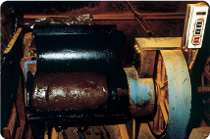 Once the mixture turns into a clay form, it is placed in a compressor-type molding machine to make 10 kg pieces of incense. Each piece is wrapped up in plastic, cooled by water and left overnight to mature.
Once the mixture turns into a clay form, it is placed in a compressor-type molding machine to make 10 kg pieces of incense. Each piece is wrapped up in plastic, cooled by water and left overnight to mature. -
Pushing out/ Tray cutting
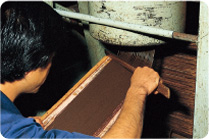 Each piece is placed into an extruding machine and pushed through. When the thin strings of senko come out, the skilled craftsman receives them on a tray and cuts them into a uniform length.
Each piece is placed into an extruding machine and pushed through. When the thin strings of senko come out, the skilled craftsman receives them on a tray and cuts them into a uniform length. -
Moving
The senko sticks are moved skillfully from the tray to drying boards with a bamboo spatula and by hand. Crooked sticks are thrown out at this point. -
Cutting
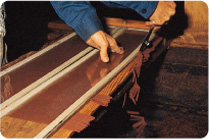 All the senko sticks are cut into the same length using a rotary cutter.
All the senko sticks are cut into the same length using a rotary cutter. -
Drying
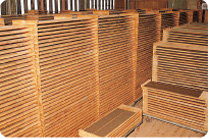 Senko is best dried naturally.
Senko is best dried naturally.
It dries in a few days during summer and over 10 days in winter. -
Bending prevention
During the time the senko sticks are left out to dry, they are frequently pushed closer together to prevent bending. The next step is to place the drying boards on top of each other to further prevent bending. -
Tying
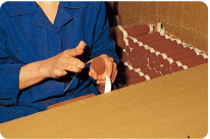 All the senko sticks are checked as they are gathered into a uniform bundle and tied together to prevent them from bending.
All the senko sticks are checked as they are gathered into a uniform bundle and tied together to prevent them from bending. -
Packing
The senko sticks are inspected, wrapped and placed in boxes.
Major Ingredients in Senko
- Aloeswood / Agallochum
- A tall evergreen tree from the thymelaeaceae family. Found mostly in Vietnam, Indonesia and Malaysia. The tree itself does not have a scent, however when an old tree is cut down and left to rot or buried for several years, the resin left behind does. This resin is called jinko, and the best quality jinko is called kyara.
- Sandalwood
- A tall evergreen tree from the sandalwood family found mostly in India. The heartwood has always been used to make aromatics, while the outer part was used to carve Buddhist figures.
- Borneo camphor
- A tall evergreen tree found in Borneo and Sumatra, well liked for its elegant, clear scent.
It is used in medicine, mothballs, and aromatics. - Clove
- Found in India, Indonesia, the Philippines, and the eastern coast of Africa. The dried flower buds are used for medicine, aromatics and spice.
- Cinnamon
- A tall evergreen tree from the camphor laurel family found in China and Indo-China. The dried bark of this tree is also known as cinnamon. It is used for aromatics and spice.
- Fennel
- An evergreen tree from the magnolia family found only in limited areas in the northern part of Indo-China and the southern part of China. Used to make aromatics and perfumed oil.
- Tabu (Machilus thunbergii )
- A tall evergreen tree from the camphor laurel family found in China, Taiwan, Thailand and Kyushu. The bark is pulverized to make adhesive for senko sticks.
[Manufacturers' Associations]
●Sakai Senko Manufacturing Association
c/o Morishima Nyokyudo
2-23, Ichino-cho Higashi 3-cho, Sakai-ku,
Sakai 590-0952
Phone: (072) 233-4913
URL:https://www.sakai
senkou.net/







